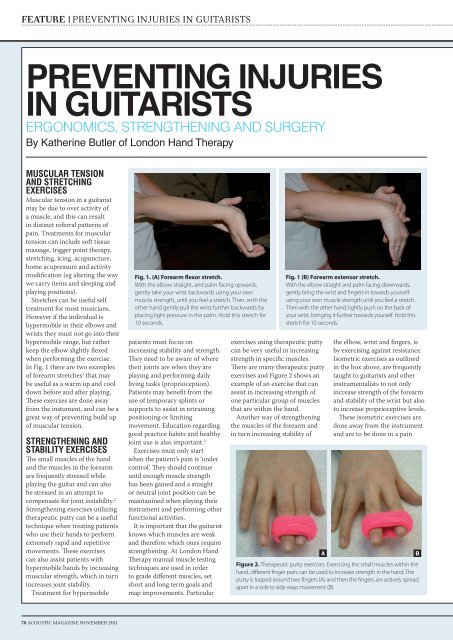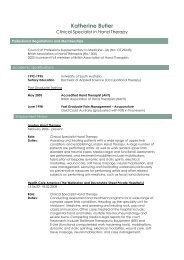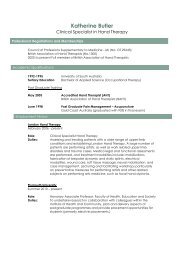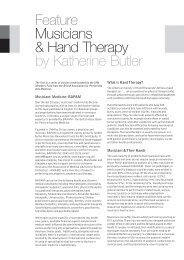Preventing injuries in guitarists - London Hand Therapy
Preventing injuries in guitarists - London Hand Therapy
Preventing injuries in guitarists - London Hand Therapy
You also want an ePaper? Increase the reach of your titles
YUMPU automatically turns print PDFs into web optimized ePapers that Google loves.
FEATURESTABILITY EXERCISES FOR THE WRIST AND FOREARMThese exercises do not <strong>in</strong>volve any movement but are static and resisted. You must support the length of your forearm on a table or flat surface. You should feelresistance rather than pa<strong>in</strong>, and only use 30% of your maximal effort <strong>in</strong>itially, and as tolerated <strong>in</strong>crease this gently and <strong>in</strong> a graded manner, up to a maximum of50%. Hold each position for 5-10 seconds and <strong>in</strong> time as tolerated gently <strong>in</strong>crease the time that the position is held so that a 30 second hold is achieved.© Butler and Coldham 2006Forward bend<strong>in</strong>gWith the palm of your handfac<strong>in</strong>g down and your handform<strong>in</strong>g a light fist, push yourforearm <strong>in</strong>to the table andfeel the resistance right up<strong>in</strong>to your upper arm.Repeat __ times __ per dayBackward bend<strong>in</strong>gWith your affected wrist <strong>in</strong>a neutral plane and whilstform<strong>in</strong>g a light fist, place yourunaffected hand over theback of the wrist and resistthe backwards movement.Repeat __ times __ per daySide to sideRest your hand and forearmwith the little f<strong>in</strong>ger <strong>in</strong>contact with the table.Make a light fist and pushthe side of your forearm <strong>in</strong>tothe table.Repeat __ times __ per dayRest your hand and forearmwith the palm fac<strong>in</strong>g thetable and make a light fist.Resist movement towards thethumb with the palm of theother hand.Repeat __ times __ per dayTurn<strong>in</strong>gRest your hand and forearmwith the little f<strong>in</strong>ger <strong>in</strong> contactwith the table, resist aga<strong>in</strong>st youraffected side us<strong>in</strong>g your otherhand. Place your unaffectedhand over the base of yourwrist. Imag<strong>in</strong>e you are turn<strong>in</strong>gyour palm down towards thetable and resist this movementwithout mov<strong>in</strong>g the wrist.Repeat __ times __ per dayfree range. Proprioception andretra<strong>in</strong><strong>in</strong>g exercises can begraded and weight bear<strong>in</strong>g <strong>in</strong>a neutral position first with theeyes open and then with theeyes closed can be anotherway to <strong>in</strong>crease the difficulty ofthese exercises.When treat<strong>in</strong>g musiciansthe musical <strong>in</strong>strument is usedas a rehabilitative tool whenpossible. In the later stages ofrehabilitation these isometricexercises can be progressedso they are more challeng<strong>in</strong>gand the musical <strong>in</strong>strumentcan be used as resistance. Forexample, the patient is asked toma<strong>in</strong>ta<strong>in</strong> a neutral jo<strong>in</strong>t positionwhile hold<strong>in</strong>g the str<strong>in</strong>g downon a guitar. 3After months of perform<strong>in</strong>gstrengthen<strong>in</strong>g exercisessymptoms can improveand it is not uncommon todetect an improvement <strong>in</strong>ligament tautness with jo<strong>in</strong>ttranslation test<strong>in</strong>g, which is veryencourga<strong>in</strong>g to both the patientand the treat<strong>in</strong>g therapist.SPLINTSTemporary supports to ma<strong>in</strong>ta<strong>in</strong>jo<strong>in</strong>t(s) <strong>in</strong> a straight (neutral)position are useful <strong>in</strong> assist<strong>in</strong>ga patient to grade their returnto play. Supports can <strong>in</strong>cludelight plastic spl<strong>in</strong>ts, neoprenewraps, wrist braces, lycra f<strong>in</strong>gersleeves, or Coban wrap (SeeFigure 3). It may take manymonths for stability and strengthto improve and spl<strong>in</strong>ts or wrapsmay need to be worn for sometime. They should be weaned asstrength <strong>in</strong>creases and symptomsdecrease.MUSICAL INSTRUMENTMODIFICATIONSThe shape of a guitar can attimes present the player withdifficulties. The right forearmmay press on the body of theguitar and cause pa<strong>in</strong> <strong>in</strong> theforearm and hand, and the leftwrist may feel it needs to bendA“EXERCISES MUSTONLY START WHENTHE PATIENT’SPAIN IS ‘UNDERCONTROL’”forwards <strong>in</strong> order to access someof the str<strong>in</strong>gs.Guitars have been designed withpart of the body of the <strong>in</strong>strumentrecessed to permit the use of amore neutral wrist and moreoptimal ergonomic position whenplay<strong>in</strong>g. 4 The resultant decrease<strong>in</strong> left wrist flexion can help avoidthe high pressures associatedwith CTS and m<strong>in</strong>imize frictionFig. 3A. Flexed wrist position utilized by some <strong>guitarists</strong> to access the lowerstr<strong>in</strong>gs; Fig. 3B. Retra<strong>in</strong><strong>in</strong>g the wrist position us<strong>in</strong>g a wrist brace to limit wristflexion and encourage more elbow and shoulder range of motion.Bof the flexor tendons aga<strong>in</strong>st thetransverse carpal ligament. Someelectric guitars avoid this problemaltogether by virtually elim<strong>in</strong>at<strong>in</strong>gthe body of the <strong>in</strong>strument.The lower “bout” of the acousticguitar (the part where the rightforearm crosses the <strong>in</strong>strument)also can present a physicalobstacle 4 result<strong>in</strong>g <strong>in</strong> eitherexcessive right wrist flexion orprotraction of the right shoulderfor the right hand to access thestr<strong>in</strong>gs. The larger the body sizeof the guitar or the smaller theplayer, the bigger the problem.Lask<strong>in</strong> 5 has developed a smallbeveled edge for the classicalguitar where the right forearmcrosses the <strong>in</strong>strument. Norris 4further developed this idea to amore radical bevel, improv<strong>in</strong>gright-hand access to the str<strong>in</strong>gswith m<strong>in</strong>imal distortion of rightshoulder and wrist position.ADAPTIVE EQUIPMENTFOR THE PHYSICALLYDISABLEDMusical <strong>in</strong>struments can bemodified or adapted to <strong>in</strong>creasethe ease of play<strong>in</strong>g for <strong>in</strong>dividualswith a physical or mentaldisability. Metal picks can befixed to the end of a prosthesis toallow guitar play<strong>in</strong>g.For quadriplegics and peoplewith severe neurologicalNOVEMBER 2011 ACOUSTIC MAGAZINE 77<strong>Hand</strong> Care_BC.<strong>in</strong>dd 19 23/09/2011 12:00
FEATUREPREVENTING INJURIES IN GUITARISTS“NON-SURGICAL TREATMENT SHOULDALWAYS BE TRIED FIRST...[TO] SOLVE THEPROBLEM RATHER THAN SURGERY”impairments, sip and puffcontrols can be adapted tothe computer and used <strong>in</strong>conjunction with one of anumber of musical softwarepackages to allow compositionand playback.Guitarists with left hand orshoulder problems can placea capo on the third fret, thusdecreas<strong>in</strong>g the amount ofcomb<strong>in</strong>ed wrist, forearm andshoulder rotation when play<strong>in</strong>gon the first three frets. Becausethe distance between the fretsdecreases as one goes higherup the neck, the f<strong>in</strong>ger spreadrequired for chords or <strong>in</strong>tervalsis also decreased. 6SURGERYSurgery on musicians must beentered <strong>in</strong>to cautiously. W<strong>in</strong>spur 7reports that of the musicianspresent<strong>in</strong>g with recognisableorthopaedic or rheumatologicconditions <strong>in</strong> the upper limb4-6% will be candidates forsurgery. Non-surgical treatmentshould always be tried first andit should not be forgotten that <strong>in</strong>some situations adjustment ormodification of the <strong>in</strong>strument orplay<strong>in</strong>g technique (the <strong>in</strong>terface)may solve the problem ratherthan surgery.The implications of surgery aregreat for a musician, whose handsare their livelihood. Thus respectfor their hand and career must beparamount. Accurate diagnosis,References1. Simmons, DG, Travell, JG and Simons, LS.Myofascial Pa<strong>in</strong> and Dysfunction. The TriggerPo<strong>in</strong>t Manual Volume 1. Upper Half of Body, 2ndEd. 1999, Lipp<strong>in</strong>cott Williams and Wilk<strong>in</strong>s.2. Brandfonbrener, A. The epidemiologyand prevention of hand and wrist <strong><strong>in</strong>juries</strong> <strong>in</strong>perform<strong>in</strong>g artists. <strong>Hand</strong> Cl<strong>in</strong>ics, 1990; 6(3): 365-77.3. Warr<strong>in</strong>gton J. <strong>Hand</strong> <strong>Therapy</strong> for the musician:<strong>in</strong>strument-focused rehabilitation. In: W<strong>in</strong>spurI & Tubiana R (ed). <strong>Hand</strong> Cl<strong>in</strong>ics, The Musician’s<strong>Hand</strong>. Philadelphia, Pennsylvania: W.B.SaundersCompany 2003 (19:2), 287-301.4. Norris RN, Dommerholt J: Appliedergonomics, Orthop Phys Ther Cl<strong>in</strong> North Am6:159, 1997.analysis of need and disability,and precision <strong>in</strong> plann<strong>in</strong>g areneeded to ensure optimaloutcome of surgery. In the areaof acute trauma, techniquesthat will permit early return tofunction (such as rigid fixation offractures and early rehabilitation)are often advantageous.Electrodiagnostically documentedcarpal/cubital tunnel syndromeand ligamentous <strong><strong>in</strong>juries</strong>lead<strong>in</strong>g to <strong>in</strong>stability that havenot responded to activitymodification or nonoperativetherapy can be consideredappropriate surgical conditions <strong>in</strong>the musician’s hand. 8W<strong>in</strong>spur 9 states that thereare four areas that must beidentified and specificallyaddressed when plann<strong>in</strong>gsurgery on a musician’s hand.1. The exact location of <strong>in</strong>cisionsavoid<strong>in</strong>g critical tactile areas(Fig 4A)2. Anatomic repair andreconstruction3. Adjustment of any anticipatedanatomic compromise tothe musician’s specificmusical needs4. The need for an early return tolimited play<strong>in</strong>g. (Fig. 4B).A large series of professionalmusicians operated on by as<strong>in</strong>gle surgeon are presented byButler and W<strong>in</strong>spur. 11 Of the totalnumber of musicians undergo<strong>in</strong>g5. Lask<strong>in</strong> W: Classical guitar “arm rest,”Guitarmaker 14:36, 1992.Fig. 4A. Because of the need to reta<strong>in</strong> full control of the tip of thedigit when <strong>in</strong> complete fl exion, rather than divid<strong>in</strong>g the A1 pulleywhich has been shown to have detrimental effects <strong>in</strong> <strong>guitarists</strong>with trigger fi nger, the ulnar slip of FDS was removed to allow morespace under A1 pulley of left r<strong>in</strong>g fi nger, without sacrifi c<strong>in</strong>g thepulley. 10 ; Fig. 4B. Guitarist play<strong>in</strong>g 4 days after surgery for trigger<strong>in</strong>gaffect<strong>in</strong>g the left r<strong>in</strong>g fi nger.hand surgery 12.3% were<strong>guitarists</strong>, this is a lot lower thanpiano/organ players (35.7%) andstr<strong>in</strong>g players (34.6%), however,the frequency of piano and str<strong>in</strong>gplayers represents the popularityof these <strong>in</strong>struments rather thana vulnerability of the players.Of the 130 patients, 127 (97.7%)returned to full time professionalwork or were able to completetheir f<strong>in</strong>al year music collegeexam<strong>in</strong>ations. The period of ‘timeoff the <strong>in</strong>strument’ follow<strong>in</strong>gsurgery is kept to a m<strong>in</strong>imum andthen there is a graded return toplay programme that is <strong>in</strong>itiatedas soon as possible.SUMMARYThe musicians hand is <strong>in</strong>tricateand beautiful. What a guitaristis required to do with their6. Butler, K & Norris, R. Chapter 142 Assessmentand treatment pr<strong>in</strong>ciples for the upperextremities of <strong>in</strong>strumental musicians. In:Skirven TM, Osterman Al, Fedorczyk J, AmadioPC, ed. Rehabilitation of the <strong>Hand</strong> and UpperExtremity, 6th ed. Mosby Elsevier; 2011: 1855-1877.7. W<strong>in</strong>spur I. Surgical <strong>in</strong>dications, plann<strong>in</strong>g andtechnique. In: W<strong>in</strong>spur I & Wynn Parry CB (ed).The Musician’s <strong>Hand</strong> a Cl<strong>in</strong>ical Guide. Ab<strong>in</strong>gdon,Oxon: Mart<strong>in</strong> Dunitz, 1998: 41- 52.8. Amadio PC. The Role of Surgery. In: TubianaR & Amadio (ed). Medical Problems of theInstrumentalist Musician. <strong>London</strong>: Mart<strong>in</strong>Dunitz, 2000: 421- 431.Awhole body is complex, and itis paramount that the musician,music teacher, educationalfacilities, health professionalsand <strong>in</strong>strument makers allwork together to prevent anddecrease the possibility of <strong><strong>in</strong>juries</strong>develop<strong>in</strong>g. Simple warm up, cooldown and strengthen<strong>in</strong>g exercises,a careful analysis of the play<strong>in</strong>gposition and an ergonomicapproach to the <strong>in</strong>strument canassist the musician <strong>in</strong> decreas<strong>in</strong>gthe possibility of an acquired <strong>in</strong>juryand facilitate a more enjoyableperformance experience.9. W<strong>in</strong>spur I. Special operative considerations<strong>in</strong> musicians. In: W<strong>in</strong>spur I & Tubiana R (ed).<strong>Hand</strong> cl<strong>in</strong>ics, The Musicians <strong>Hand</strong>. Philadelphia,Pennsylvania: W.B.Saunders Company, 2003(19:2), 247-258.10. Ragoowansi R and W<strong>in</strong>spur I. Solutions totwo difficult surgical problems <strong>in</strong> musicians.Medical Problems of Perform<strong>in</strong>g Artists, 2008;23: 16-19.11. Butler K, W<strong>in</strong>spur I ‘Retrospective casereview of time taken for 130 professionalmusicians to fully return to play<strong>in</strong>g their<strong>in</strong>struments follow<strong>in</strong>g hand surgery’ <strong>Hand</strong><strong>Therapy</strong>, 2009, 14: 69-74.B78 ACOUSTIC MAGAZINE NOVEMBER 2011<strong>Hand</strong> Care_BC.<strong>in</strong>dd 20 23/09/2011 12:00







